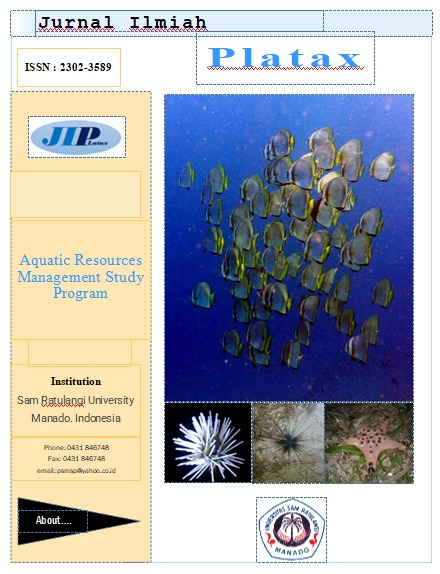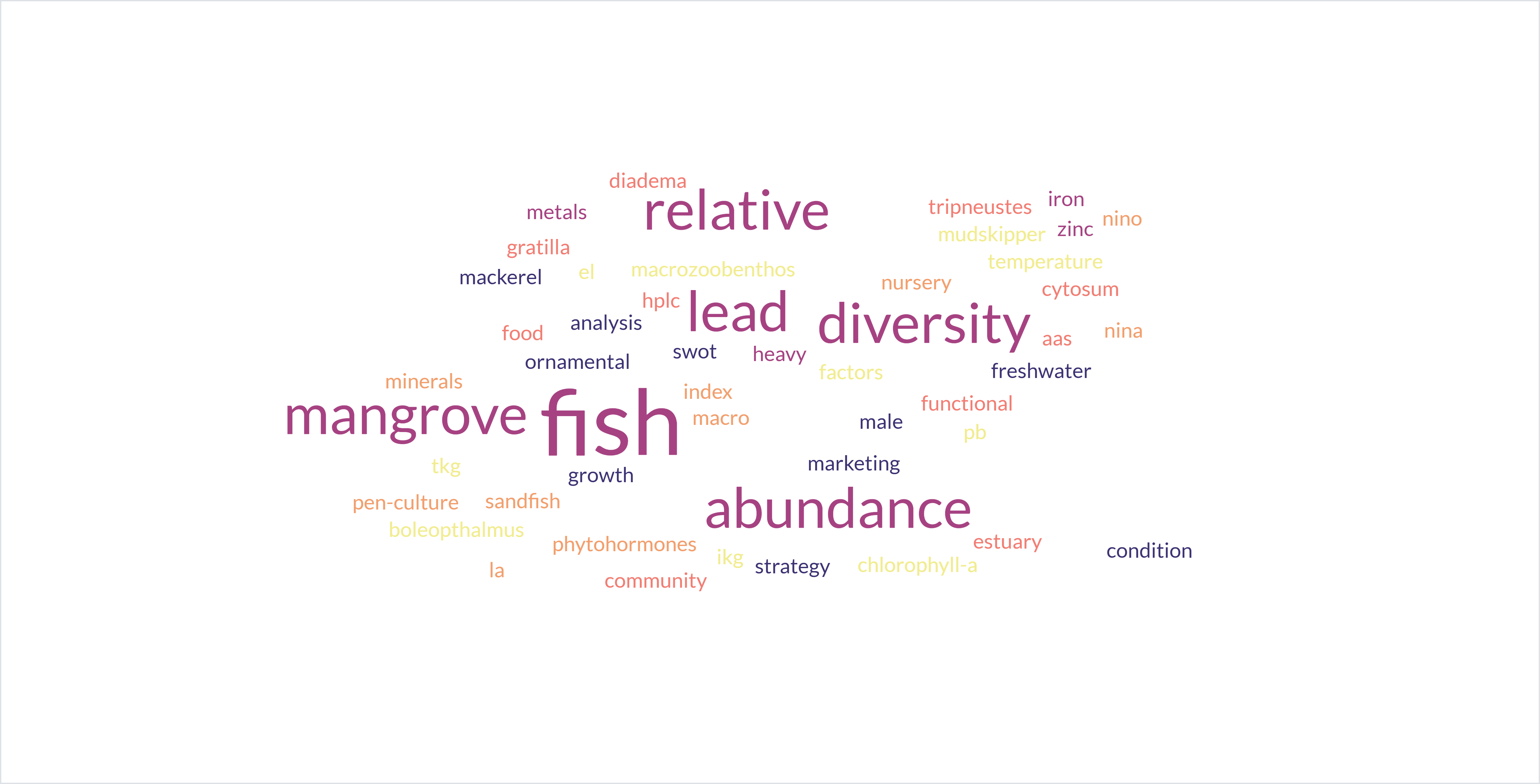Surface Thermal Front Persistence in Malacca Strait
DOI:
https://doi.org/10.35800/jip.v10i2.40879Keywords:
Malacca Strait, sea surface temperature, thermal front.Abstract
The Malacca strait is an essential seaway for international sea traffic and a provider of biological and non-biological resources. This strait has dynamic conditions resulting from the interaction between the Indian Ocean in the north and the Pacific Ocean in the south. The characteristic of the thermal front is the strait dynamics that have not been studied comprehensively. This research aims to map and identify the spatial and temporal pattern of the thermal front in Malacca Strait. The data used are sea surface temperature of AquaMODIS level 3 satellite images and bathymetry data of Malacca Strait, Ocean Nino Index (ONI), and Dipole Mode Index (DMI). The sea surface temperature data were processed from 2010 to 2020 using the Single Edge Image Detection (SIED) method. This research denotes the thermal front phenomenon found with several variations in each season. The highest (lowest) number of thermal fronts was discovered in the east season (first transitional season). The total number of thermal fronts each year happened to be maximum in 2015 and minimum in 2019. Annual variability (ENSO and IOD) impacts the number of thermal front events, but the observation period has to be explicitly adjusted in the analysis needed. Persistent thermal fronts in the Malacca Strait occurred in 1-5 repetitions at the exact location. Thermal fronts are commonly found in the northern region of the strait and areas with significant depth changes.
Keywords: Malacca Strait; sea surface temperature; thermal front.
Abstrak
Selat Malaka terkenal sebagai perairan penting dalam lalu lintas laut internasional serta penyedia sumber daya hayati dan non hayati. Perairan ini juga memiliki kondisi yang dinamis sebagai hasil interaksi antara Samudera Hindia di bagian utara serta Samudera Pasifik di bagian selatan selat. Dinamika perairan yang belum dikaji secara komprehensif di perairan ini adalah karakteristik thermal front. Sehingga tujuan dari penelitian ini adalah memetakan secara spasial dan temporal kejadian thermal front di perairan Selat Malaka serta menganalisis karakteristik dari thermal front yang dipetakan tersebut. Data yang digunakan pada penelitian ini adalah data suhu permukaan laut citra satelit AquaMODIS level 3, data batimetri Selat Malaka, serta data Ocean Nino Index (ONI) dan Dipole Mode Index (DMI). Metode Single Edge Image Detection (SIED) digunakan untuk mengolah data suhu permukaan laut pada periode pengamatan tahun 2010 hingga 2020. Hasil penelitian ini menunjukkan bahwa di perairan Selat Malaka dapat ditemukan thermal front dengan jumlah variatif setiap musim. Jumlah thermal front tertinggi ditemukan pada musim timur dan terendah pada musim peralihan 1. Jumlah total thermal front setiap tahun ditemukan maksimum pada tahun 2015 dan minimum pada tahun 2019. Variabilitas annual (ENSO dan IOD) memberikan dampak terhadap jumlah kejadian thermal front, namun untuk kebutuhan analisis perlu disesuaikan terhadap periode pengamatan dari variabilitas tersebut. Thermal front persisten di Selat Malaka dapat terjadi pada rentang 1-5 kali pengulangan pada lokasi yang sama. Lokasi thermal front persisten lebih sering terjadi di wilayah utara selat dan/atau pada wilayah dengan perubahan kedalaman yang signifikan.
Kata kunci: Selat Malaka, suhu permukaan laut, thermal front.
References
Ahmad, A. L., Syamsuddin, M. L., Purba, N. P., dan Sunarto. (2019). Thermal front condition through El Nino and Indonesian throughflow phase in southern sea of East Java and Bali on the east monsoon. IOP Conf. Series: Earth and Environmental Science, 303, 1-8.
Akbari, E., Alavipanah, S.K., Jeihouni, M., Hajeb. M., Haase, D., dan Alavipanah, S. (2017). A review of ocean/sea subsurface water temperature studies from remote sensing and non-remote sensing methods. Water, 9, 1-25.
Amiruddin, A. M., Ibrahim, Z. Z., dan Ismail, S. A. (2011). Water mass characteristic in the Strait of Malacca using ocean data view. Research Journal of Environmental Science, 5(1), 49-58.
BIG (Badan Informasi Geospasial) Republik Indonesia. https://tanahair.indonesia.go.id/demnas/#/batnas. Diakses pada: 26-27 Maret 2022.
Belkin, I. M. dan Cornillon, P.C. (2003). SST fronts of the Pacific Coastal and marginal sead. Physical Oceanography, 1(2), 90-114.
Belkin, I. M., Cornillon, P.C., Sherman, K. (2009). Front in large marine ecosystem. Progress in Oceanography, 81, 223-236.
Cayula, J. dan Cornillon, P. (1992). Edge detection algorithm for SST images. Journal of Atmospheric and Oceanic Technology, 9, 67-80.
Chen, L., Li, T., Wang, B., Wang, L. (2017). Formation mechanism for 2015/16 super El Nino. Nature Scientific Reports, 7, 1-10.
Daulay, S.R., Sari, T.E.Y., Usman, U., Jhonneri, R. (2019). Karakteristik thermal front di Perairan Tropis Samudra Hindia bagian timur. Jurnal Perikanan, 21(1), 25-29.
Ginzburg, A.I. dan Kostianoy, A.G. (2009). Fronts and mixing processes. Encyclopedia of Life Support System, 237-267.
Haditiar, Y., Putri, M., Ismail, N., dan Muchlisin, Z. A. (2020). Numerical study of tides in Malacca Strait with a 3-D model. Research Article Heliyon-Elsevier, 6, 1-16.
Hamzah, R., Prayolo, T., Harsanugraha, W. K. (2014). Identifikasi thermal front dari data satelit Terra/Aqua Modis menggunakan Single Image Edge Detection (SIED) Studi Kasus: Perairan Utara dan Selatan Pulau Jawa. Seminar Nasional Penginderaan Jauh, 552-559.
Hanintyo, R., Hadianti, S., Mahardhika, R.M.P., Aldino, J.S., Islamy, F. (2015). Sebaran musiman kejadian thermal front berdasarkan citra Aqua-MODIS di WPP-RI 714, 715, dan 716. Seminar Nasional Penginderaan Jauh, 523-531.
Isa, N. S., Akhir, M. F., Khalil, I., Kok, P. H., dan Roseli, N. H. (2020). Seasonal characteristics of the sea surface temperature and sea surface current of the Strait of Malacca and Andaman Sea. Journal of Sustainability Science and Management, 15(4), 66-77.
Jatiandana, A. P. dan Nurdjaman, S. (2020). Identification of thermal front in Indonesian Waters during 2007-2017. IOP Conf. Series: Earth and Environmental Science, 618, 1-7.
Jatisworo, D. dan A. Murdimanto. (2013). Identifikasi thermal front di Selat Makassar dan Laut Banda. Balai Penelitian dan Observasi Laut.
Japan Meterological Agency (JMA). https://ds.data.jma.go.jp/tcc/ /tcc/products/elnino/index/sstindex/sliding_30year_period/DMI/3rmean. Diakses pada: April 2022.
Miller, P.I. 2011. Detection and visualization of oceanic fronts from satellite data, with application for fisheries, marine megafauna, and marine protected areas. Handbook of Satellite Remote Sensing Image Interpretation: Applications for Marine Living Resources Conservation and Management, Plymouth, 229-239.
Mohanty, P.C., Mahendra, R.S., Nayak, R.K., Kumar, N., Kumar, S.T., Dwivedi, R.M. (2017). Persistence of productive surface thermal fronts in the Northeast Arabian Sea. Regional Studies in Marine Science, 1-28.
NASA Goddard Space Flight Center, Ocean Ecology Laboratory, Ocean Biology Processing Group. Moderate-resolution Imaging Spectroradiometer (MODIS) Aqua Sea Surface Temperature Data; NASA OB.DAAC, Greenbelt, MD, USA. Diakses pada: Maret 2022.
NOAA (The National Oceanic and Atmospheric Administration), https://www.cpc.ncep.noaa.gov/data/indices/oni.ascii.txt. Diakses pada: April 2022.
Priede, I.G. dan Miller, P.I. (2009). A basking shark (Cetorhinus maximus) tracked by satellite together with simultaneous remote sensing II: new analysis reveals orientation to a thermal front. Fisheries Research, 95, 253-277.
Peraturan Menteri Kelautan dan Perikanan Republik Indonesia Nomor 18 Tahun 2014
Puthezath, A. S. (2014). Identification of thermal fronts in the Arabian Sea using MODIS-SST data. Thesis Master of Science, Kerala University of Fisheries and Ocean Studies Panangad, 1-70.
Rizal, S., Damm, P., Wahid, M. A., Sundermann, J., Ilhamsyah, Y., Iskandar, T., dan Muhammad. (2012). General circulation in the Malacca Strait and Andaman Sea: A numerical model study. American Journal of Environmental Science, 8(5), 479-488.
Sakmani, A. A., Lam, W.H., Hashim, R., Chong, H.Y. (2013). Site selection for tidal turbine installation in the Strait of Malacca. Renewable and Sustainable Energy Reviews, 21, 590-602.
Sholva, Y., Sitohang, B., Wikantika, K. (2013). New approach to locate upwelling and thermal front from satellite imagery data. Procedia Technology, 11, 317-326.
Simbolon, D., Silvia, Wahyuningrum, P.I. (2013). The prediction of thermal front and upwelling as indicator of potential fishing ground in Mentawai water. Journal of Marine Fisheries, 4(1), 85-95.
Siswanto, E. dan Tanaka, K. (2014). Phytoplankton biomass dynamics in the Straits of Malacca within the period of the SeaWiFS full mission: seasonal cycles, interannual variation and decadal-scale trend. Remote Sensing, 6, 2718-2742.
Sulistya, W., Hartoko, A., dan Prayitno, S.B. (2007). The characteristic and variability of sea surface temperature in Java Sea. Remote Sensing and Earth Science, 4, 85-94.
Trinugroho, T., Satriadi, A., dan Muslim. (2019). Sebaran thermal front musiman di wilayah perairan Selat Madura menggunakan single image edge detection. Journal of Marine Research, 8(4), 416-423.
Valavanis, V. D., Katara, I., dan Palialexis, A. (2005). Marine GIS: identification of mesoscale oceanic thermal front. International Journal of Geographical Information Science, 19(10), 1311-1147.
Yanagi, T. (1987). Classification of “siomeâ€, streaks, and fronts. Journal of Oceanography Society of Japan, 45, 149-158.
Downloads
Published
How to Cite
Issue
Section
License
COPYRIGHT
Authors who publish with this journal agree to the following terms:
Authors hold their copyright and grant this journal the privilege of first publication, with the work simultaneously licensed under a Creative Commons Attribution License that permits others to impart the work with an acknowledgment of the work's origin and initial publication by this journal.
Authors can enter into separate or additional contractual arrangements for the non-exclusive distribution of the journal's published version of the work (for example, post it to an institutional repository or publish it in a book), with an acknowledgment of its underlying publication in this journal.
Authors are permitted and encouraged to post their work online (for example, in institutional repositories or on their website) as it can lead to productive exchanges, as well as earlier and greater citation of the published work (See The Effect of Open Access).






































